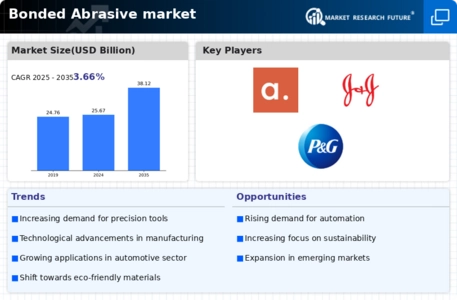Market Trends and Growth Projections
The Global Bonded Abrasive market Industry is characterized by various trends and growth projections. The market is expected to experience a steady increase, with projections indicating a rise from 25.67 USD Billion in 2024 to 38.12 USD Billion by 2035. The anticipated CAGR of 3.66% from 2025 to 2035 highlights the industry's resilience and adaptability to changing market dynamics. Factors such as technological advancements, increasing demand from key sectors, and a focus on sustainability are likely to shape the future landscape of the bonded abrasives market.
Rising Demand for Precision Engineering
The rising demand for precision engineering across various industries is a notable driver for the Global Bonded Abrasive market Industry. Industries such as aerospace, medical devices, and electronics require high-precision components, which necessitate the use of specialized bonded abrasives. These abrasives enable manufacturers to achieve tight tolerances and superior surface finishes. As industries increasingly prioritize quality and precision, the demand for advanced bonded abrasives is expected to grow. This trend aligns with the overall market growth trajectory, reinforcing the importance of precision engineering in driving the bonded abrasives sector.
Increasing Demand from Automotive Sector
The automotive sector represents a substantial driver for the Global Bonded Abrasive market Industry. As vehicle manufacturing continues to expand, the need for high-quality abrasives for grinding, polishing, and finishing applications becomes critical. In 2024, the market is projected to reach 25.67 USD Billion, largely fueled by innovations in automotive design and manufacturing processes. The demand for precision-engineered components necessitates the use of bonded abrasives, which enhance efficiency and product quality. This trend is expected to persist, as automotive production is anticipated to grow, thereby bolstering the bonded abrasives market further.
Growth in Construction and Infrastructure Projects
The growth in construction and infrastructure projects worldwide serves as a significant driver for the Global Bonded Abrasive market Industry. As urbanization accelerates, the demand for bonded abrasives in construction activities rises. These abrasives are essential for cutting, grinding, and finishing materials used in building and infrastructure development. The increasing investment in infrastructure, particularly in emerging economies, is expected to propel market growth. With the market projected to reach 38.12 USD Billion by 2035, the construction sector's reliance on bonded abrasives is likely to remain a key factor in shaping industry dynamics.
Environmental Regulations and Sustainable Practices
Environmental regulations and the push for sustainable practices are influencing the Global Bonded Abrasive market Industry. Manufacturers are increasingly adopting eco-friendly materials and processes to comply with stringent regulations. This shift towards sustainability is prompting the development of bonded abrasives that minimize environmental impact while maintaining performance. The growing awareness of environmental issues among consumers and industries is likely to drive demand for sustainable abrasive solutions. As a result, the market may witness a transformation, with an emphasis on environmentally responsible products becoming a key factor in future growth.
Technological Advancements in Abrasive Manufacturing
Technological advancements in the production of bonded abrasives significantly influence the Global Bonded Abrasive market Industry. Innovations such as the development of advanced ceramic and resin-bonded abrasives enhance performance and durability. These improvements lead to increased efficiency in various applications, including metalworking and woodworking. The ongoing research and development efforts are likely to result in new products that meet the evolving demands of industries. As a result, the market is expected to grow steadily, with a projected CAGR of 3.66% from 2025 to 2035, indicating a robust future for technologically advanced bonded abrasives.














Leave a Comment